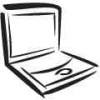Acer TravelMate 310 User Guide - Page 60
User's Guide, Hard Disk Standby Mode, Peripheral Standby Modes, Standby mode
 |
View all Acer TravelMate 310 manuals
Add to My Manuals
Save this manual to your list of manuals |
Page 60 highlights
310-e.book Page 40 Tuesday, October 27, 1998 5:17 PM Power Management Hard Disk Standby Mode The hard disk enters standby mode when there are no disk read/write operations within the period of time specified by the Hard Disk Timeout. In this state, the power supplied to the hard disk is reduced to a minimum. The hard disk returns to normal once the computer accesses it. Peripheral Standby Modes The peripheral connections in your computer also power down to save power if there is no activity within the period of time specified by Timeout values for these devices. These include audio, serial ports, floppy drive and parallel port. Standby mode The computer consumes very low power in Standby mode. All data remains intact in the system memory until the battery is drained. There is one necessary condition for the computer to enter Standby mode: u Heuristic Power Management must be set to [ENABLED] There are five ways to enter Standby mode: u Pressing the Standby hot key Fn-F3 u Allowing the waiting time determined by the Standby Timeout to elapse without any system activity u Closing the display cover u Allowing the computer to enter Hibernation mode when battery is low, but u the Hibernation file is invalid or not present, or u Allowing the operating system power saving modes to invoke it 40 User's Guide















